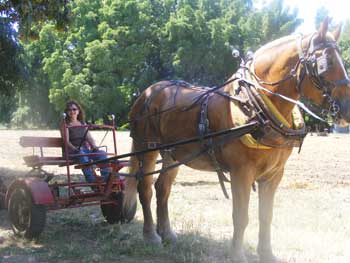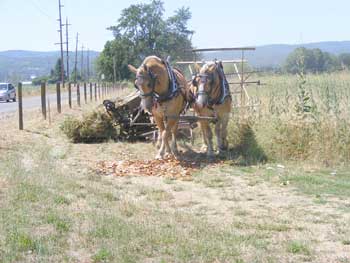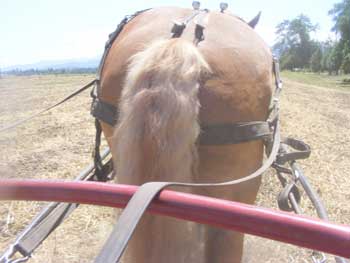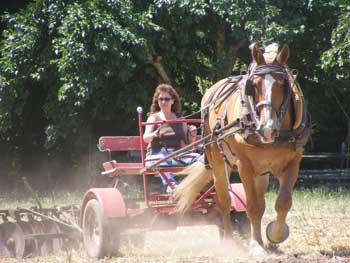Harvest Days at the farm was fantastic! August 3-5, equipment was set up, and wheat bound and sheaved in preparation for threshing on August 6. August 4, horse, man and binding equipment worked together to cut the wheat and bind it into small bundles, or sheaves. The sheaves were then gathered and stacked into shocks (resembling small teepees!) to allow the grain to dry before being threshed. But Mother Nature did not cooperate and the wheat wasn’t ready to thresh; threshing has been tentatively rescheduled for August 20.
The binder has quite a history! Prior to the binder, farmers manually cut the plants, bound the wheat stalks into sheaves, separated out the grain (threshing), and finally ground the grain into flour. This was labor-intensive, tedious work. I read that, prior to the 1830s, a farmer could harvest about an acre or less per day. Then, Cyrus McCormick and Obed Hussey independently invented horse-drawn machines,
reapers that cut the wheat using a cutting bar powered by the machine’s wheels. Once the wheat was cut, the stalks fell onto a wooden deck, and then were automatically swept off to the ground. This simplified the farmer’s work, but laborers still needed to rake and tie the wheat into sheaves and build shocks. Then, in 1872, Charles Withington invented the reaper-binder, or binder. So, in addition to cutting the wheat, the reaper-binder would also bind the wheat stalks into sheaves. These early binders were horse-drawn and powered by a bull wheel, just as the binding equipment in use at Hanley Farm!
While visitors did not get to watch the horses and thresher August 6, they were treated to watching the draft horses disc the fields! Kimber South, of the Hanley Historical Farming Committee, invited me to ride with her as she and her Belgian, Rex, disked. What an experience that was! Here I am, a city-girl, born and raised in San Francisco, CA, riding behind Rex, who weighs 2300 pounds and is 19 hands tall. (Or 6.3 feet
from the ground to the highest part of his withers, or shoulders; a hand is roughly 4 inches.) At one point, Kimber asked if I would hold the reins as she made an adjustment. She said not to worry, if Rex started to move I was to pull back on the reins and say “Whoa!” Right. Fortunately, Rex did not move. Which brings to mind a story Kimber told me when she first introduced me to Rex. She said that a “different” language is used when training a horse. For instance, Rex’s command to move is a “smooching” or “kissing” sound. With this thought in mind, her husband came home from work when she was in the pasture, working with Rex. As he approached Kimber, he said something akin to “Hi, Honey,” puckered his lips and made kissing sounds. Well, you can guess what Rex did!
As summer passes and fall is upon us, we have a special treat for you in October! But first, here’s what’s happening in September.
September 11, the Hanley Historical Farming Committee will be pressing straw! Rebuilt in 2001, it’s estimated that the straw-presser in use at the farm is from the late 1880s, possibly early 1900s. Come and see how straw is pressed and baled!
Other events on September 11 include scarecrow-making workshops, held at 11:00 am, 12:30 and 2:00 pm. The cost for the workshop is $10 and all supplies will be provided. Why scarecrow making? Hint–our October surprise! We’ll also be conducting Hanley House tours throughout the day. Cost is $3.
For more information about Hanley Farm or upcoming events, call us at 541-773-2675; e-mail us at hanleyfarm@sohs.org; visit us on-line at www.sohs.org/properties/hanley-farm; or check out our Hanley Farm Facebook page!
Hanley Farm, owned and operated by the Southern Oregon Historical Society, is located at 1053 Hanley Road, between Jacksonville and Central Point.





